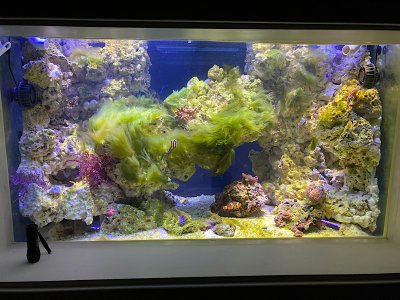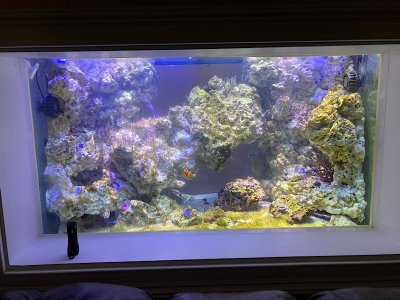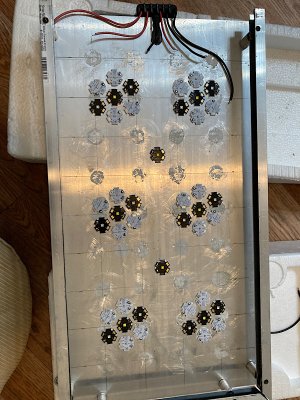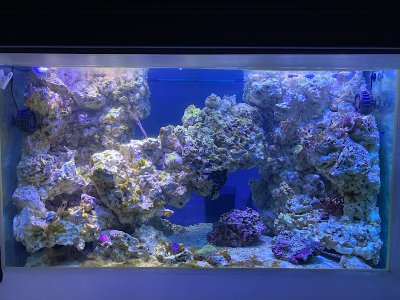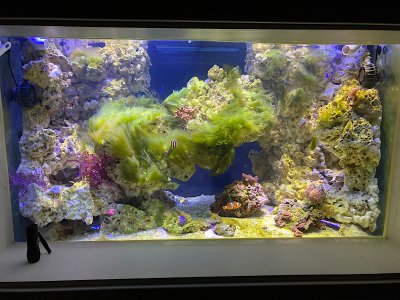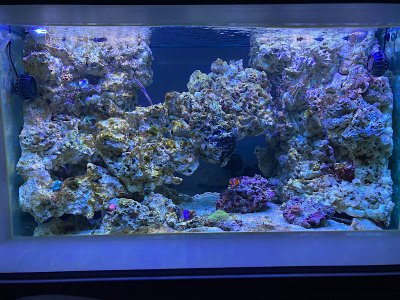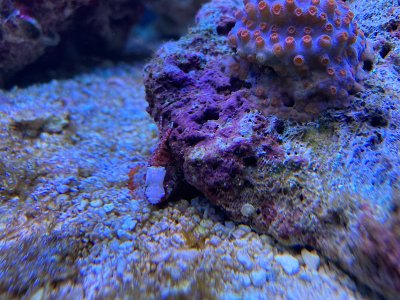Definitely looks like a polyclad of some sort.
You are using an out of date browser. It may not display this or other websites correctly.
You should upgrade or use an alternative browser.
You should upgrade or use an alternative browser.
Now or never…my 140 gallon DSA rebuild
- Thread starter T Diddy
- Start date
T Diddy
Happy to be here
The fluconazole treatment began today. I’ve been too embarrassed to post any pictures of the aquarium. This is the worst bryopsis infestation I’ve ever had. As much as I hate medicating reef tanks, it simply had to be done. I’ll post some before/after pics in a couple of weeks. With any luck, I won’t lose anymore corals than the algae has already smothered and killed. Wish me luck!
T Diddy
Happy to be here
Well, here’s an update … two weeks into the flucon treatment, the bryopsis seems to be on its last leg. I’ve been trying to manually remove what remains, but the holdfasts are still quite strong. Here’s the before and after
Attachments
T Diddy
Happy to be here
Unfortunately, I’ve been watching the slow motion train wreck of my very first crash in 35 years of aquarium husbandry. The bryopsis smothered a few of my favorite corals. Then, my sailfin tang mysteriously died, but I didn’t find/remove him until probably 3 days later. Everything started looking terrible out of nowhere (then I noticed the dead tang). Sure enough, tested positive for a little ammonia. No matter what I did, I couldn’t stop it. There are a few corals that still look like they could go either way; they could die tomorrow, or possibly recover. Interestingly, I’ve got two acros and a crocea clam that seem unaffected. The water has been testing all zeros across the board for two days now. I even dusted off my protein skimmer, and it has yet to produce the first cup of skimmate. I’m currently in the midst of performing another water change . I feel like a total newb, like I’m totally clueless as to what is happening. It’s beyond frustrating.
T Diddy
Happy to be here
It’s just crazy. Everything was doing so, so well…even through the flucon treatment. Then, all of a sudden, everything starts dying one by one! If I didn’t know any better, I’d say someone poisoned my aquarium!Glad to hear about the Bryopsis. Sorry to hear about the other issues.
I dosed Flucon a couple days ago and am starting to see the small patch of Bryopsis thin out.
T Diddy
Happy to be here
Honestly, it’s just been one disaster after the next, but with a few highlights sprinkled in. As I mentioned, I had an extended tank crash as a result of all of the bryopsis die off, coupled with the dead tang that I was unable to retrieve for three days (at least). Ammonia spiked, more corals died, and just kept the tank crash going like a slow motion train wreck. There was more die off than I care to admit…I even need to replenish my pod populations.How’s things going? My Bryopsis is gone now. No impact to the Caulerpa so far.
The good news is that the bryopsis suffered greatly, and some of the coral seems to have ridden out the storm. The purple plume gorgonian didn’t make it, but the purple candelabra gorgonian is recovering nicely with polyps extended. The crocea clam is doing fine, and a couple of acros seem to be coming back around as well. The red gracilaria was unaffected.
Furthermore, I discovered (after the fact) that my filter socks had been washed in splashless bleach. I’m pretty confident that this mistake had a major impact on the less than stellar overall condition of the aquarium.
It’s all a result of me doing stupid rookie things, the worst of which was adjusting my aquarium to suit an individual coral. I just HAD to have some euphyllia , and that meant reducing the flow in the tank…big mistake. As a result, the bryopsis took over, smothered my favorite acros, and got me into the situation where I am today.
I’m cranking the flow back up and sticking with my initial SPS plan. If something can’t handle the flow, then it doesn’t belong in my aquarium…no more special accommodations for a stupid “must have” coral.
In other news, there was a shipping delay on one of my LED orders, so I’m still waiting to get the lights upgraded, but they should be here within the next few days. I did go ahead and buy a Vabira PAR meter. I’m itching to see how my upgraded lights compare to the 12-13 year old technology that currently exists. It’s still in the box as it just arrived this evening. I plan on posting some more pics as soon as I get one of the LED arrays upgraded, and be able to show a side by side comparison, as well as PAR numbers…should be interesting. If it does what I think it will, I’ll have saved a shload of money by building it myself.
T Diddy
Happy to be here
The first panel/array is glued down. I’ll wire it up tomorrow and post side by side pics. Each cluster has 2 Royal Blue, 2 violet, 1 blue, 1 cyan, and 1 cool white. Additionally, I added 2 warm whites down the center line. If I need more light, I’ll make 2 more clusters around the warm white LEDs. The current plan is a total of 44 LED per array, and can be expanded to 56 total LEDS without having to change drivers.
Attachments
T Diddy
Happy to be here
The results are in…and there’s quite a bit to consider. The left side is the original light with cool white and Royal blue, totaling 36 LEDs. Each LED has 40 degree optics. I used the optics due to the 30” height of the tank. As a result, there are obvious “hot spots”.
The right side now has a good mix of colored LEDs, with far fewer “whites”, totaling 44 LEDs. I didn’t put any optics on the right side (yet).
By comparison, the right side has much better light spread with less shadowing. The left side has an obvious spotlight effect as a result of the optics, and the harsh white light looks a lot brighter.
I used a Vabira PAR meter to compare the two. The readings (just below water surface) jump around quite a bit on the left side due to the optics…as much as 850-900 to 350-300. The spotlight effect is not noticeable at the sandbed, with readings just above 100.
Interestingly, the right side gave me a bit of a surprise. The readings on the right side (no optics) are pretty consistent, no matter the location at any given depth…ie. The readings were very similar in the front, back, and middle of the tank. Just below the water surface, the readings were around 350. The sandbed readings were similar to the left side at just over 100.
I’m wondering if the Vabira is capable of giving accurate PAR measurements from the more blue/violet wavelengths based upon these results. Again, there are 20% more LEDs on the right, and they are presumably higher power, higher efficiency, and running at higher current. Even without the optics, I would have expected a little more in the way of PAR. I’ve got a funny feeling that adding a few more white LEDs would make the Vabira show a lot more PAR.
Any thoughts?
The right side now has a good mix of colored LEDs, with far fewer “whites”, totaling 44 LEDs. I didn’t put any optics on the right side (yet).
By comparison, the right side has much better light spread with less shadowing. The left side has an obvious spotlight effect as a result of the optics, and the harsh white light looks a lot brighter.
I used a Vabira PAR meter to compare the two. The readings (just below water surface) jump around quite a bit on the left side due to the optics…as much as 850-900 to 350-300. The spotlight effect is not noticeable at the sandbed, with readings just above 100.
Interestingly, the right side gave me a bit of a surprise. The readings on the right side (no optics) are pretty consistent, no matter the location at any given depth…ie. The readings were very similar in the front, back, and middle of the tank. Just below the water surface, the readings were around 350. The sandbed readings were similar to the left side at just over 100.
I’m wondering if the Vabira is capable of giving accurate PAR measurements from the more blue/violet wavelengths based upon these results. Again, there are 20% more LEDs on the right, and they are presumably higher power, higher efficiency, and running at higher current. Even without the optics, I would have expected a little more in the way of PAR. I’ve got a funny feeling that adding a few more white LEDs would make the Vabira show a lot more PAR.
Any thoughts?
Attachments
Last edited:
This new review on Humblefish indicates the Vabira sensor is very sensitive to positioning.The results are in…and there’s quite a bit to consider. The left side is the original light with cool white and Royal blue, totaling 36 LEDs. Each LED has 40 degree optics. I used the optics due to the 30” height of the tank. As a result, there are obvious “hot spots”.
The right side now has a good mix of colored LEDs, with far fewer “whites”, totaling 44 LEDs. I didn’t put any optics on the right side (yet).
By comparison, the right side has much better light spread with less shadowing. The left side has an obvious spotlight effect as a result of the optics, and the harsh white light looks a lot brighter.
I used a Vabira PAR meter to compare the two. The readings (just below water surface) jump around quite a bit on the left side due to the optics…as much as 850-900 to 350-300. The spotlight effect is not noticeable at the sandbed, with readings just above 100.
Interestingly, the right side gave me a bit of a surprise. The readings on the right side (no optics) are pretty consistent, no matter the location at any given depth…ie. The readings were very similar in the front, back, and middle of the tank. Just below the water surface, the readings were around 350. The sandbed readings were similar to the left side at just over 100.
I’m wondering if the Vabira is capable of giving accurate PAR measurements from the more blue/violet wavelengths based upon these results. Again, there are 20% more LEDs on the right, and they are presumably higher power, higher efficiency, and running at higher current. Even without the optics, I would have expected a little more in the way of PAR. I’ve got a funny feeling that adding a few more white LEDs would make the Vabira show a lot more PAR.
Any thoughts?
Apogee 510 vs vabira VBR aqua PAR meters
T Diddy
Happy to be here
If nothing else, the correction factor works in my favor…I can definitely grow coral with the new lights and no optics. It is very interesting that the reading changes just by rotating the sensor (without regard to angle of incidence).This new review on Humblefish indicates the Vabira sensor is very sensitive to positioning.
Apogee 510 vs vabira VBR aqua PAR meters
I’ll definitely continue to play with it and try different mounting heights/ angles. I’m still glad I bought the meter. It’s worth it to me just for the baseline comparison, and then correctly placing coral in the future.
T Diddy
Happy to be here
The lights are finally “finished”. I’m thinking of adding some more LEDs and playing with the color scheme, but overall, it’s much better than before in my opinion. The old lights worked great, but were just too harsh and didn’t really bring out any coral color. Now it’s time to get some more coral in the tank to enjoy the new lights 
Here’s a before with the bryopsis problem in full swing, and the after photo shows the new lights and no more bryopsis (thankfully).
Here’s a before with the bryopsis problem in full swing, and the after photo shows the new lights and no more bryopsis (thankfully).
Attachments
T Diddy
Happy to be here
It worked for sure. My unrelated tank crash forced me to do some water changes, so I may have to do it again, but it’s all good at the momentSo, the flucan worked for you too
Similar threads
- Replies
- 3
- Views
- 173

